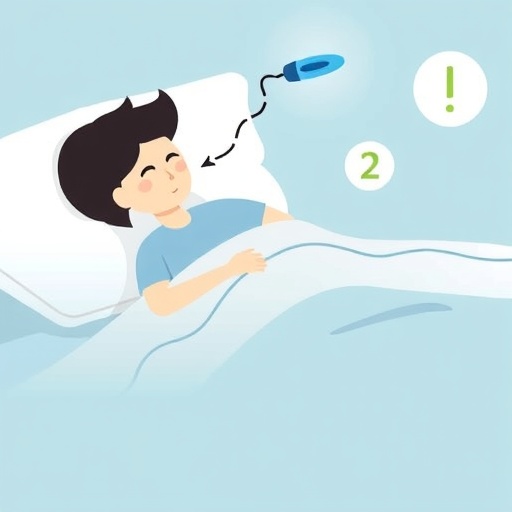In recent years, the integration of technology into health management has opened new avenues for understanding chronic conditions. A pivotal study investigates the intersection between continuous glucose monitoring (CGM) and sleep apnea, particularly focusing on individuals with and without diabetes mellitus. This research contributes significantly to existing literature by elucidating how glucose patterns may be affected by the presence of obstructive sleep apnea (OSA), a condition that has garnered widespread attention due to its rising prevalence and impact on overall health.
Diabetes mellitus is a complex metabolic disorder characterized by elevated blood glucose levels. It may arise from insulin resistance, insufficient insulin production, or both. The importance of managing glucose levels is paramount for individuals with diabetes to prevent complications such as cardiovascular disease, nerve damage, and kidney failure. Continuous glucose monitoring systems have revolutionized diabetes management by allowing real-time tracking of blood glucose levels. These devices provide valuable insights, enabling better therapeutic decisions.
Conversely, obstructive sleep apnea is a sleep-related breathing disorder. It results from the repeated collapse of the upper airway during sleep, leading to intermittent hypoxia and disrupted sleep patterns. OSA is associated with a myriad of adverse health outcomes, including hypertension, stroke, and metabolic dysfunction. Given the complex relationship between sleep and metabolic health, there is a growing interest in how sleep-disordered breathing influences glucose metabolism.
In the study led by Gouveri et al., researchers examined various cohorts to explore the implications of glucose monitoring in the context of sleep apnea. Utilizing data from participants both with and without diabetes mellitus, the researchers aimed to identify distinct glucose fluctuation patterns and how these patterns correlate with episodes of apnea and hypopnea. The study’s design was meticulous, employing rigorous methodologies to ensure reliable and valid results.
Data collection involved deploying state-of-the-art continuous glucose monitors alongside polysomnography, an overnight sleep study that records brain waves, oxygen levels, heart rate, and breathing. By comparing glucose data from different individuals, authors identified trends suggesting that untreated sleep apnea may exacerbate dysglycemia, particularly in individuals who already have compromised glucose metabolism.
Moreover, the findings highlight a concerning trend: individuals who experience severe OSA may face more significant challenges in achieving stable glucose levels. This disruption may be attributed to the intermittent hypoxia caused by sleep apnea, which is known to influence insulin sensitivity and glucose utilization in various tissues. The connection between sleep disturbances and metabolic dysregulation offers critical insights that could lead to more integrated treatment approaches.
Contrastingly, participants without diabetes but suffering from sleep apnea also exhibited abnormal glucose responses, underscoring the notion that OSA may not solely be a complication of diabetes but could be an independent risk factor affecting glucose homeostasis. This revelation carries profound implications for how clinicians approach treatments for individuals with sleep-disordered breathing, even when they are not diabetic.
In terms of clinical significance, the researchers advocate for enhanced screening measures for individuals with OSA, particularly regarding glucose tolerance tests. Given the potential for sleep apnea to alter metabolic parameters, healthcare providers may consider recommending CGM for at-risk populations. By doing so, early interventions could be implemented, potentially mitigating long-term complications associated with metabolic disorders.
The implications of this study extend beyond isolated individual care. Public health perspectives should factor into considerations regarding screening policies, healthcare accessibility, and education on the interplay between sleep and metabolic health. Ensuring proper awareness can lead to better outcomes, as lifestyle modifications and intervention strategies tailored to address both conditions could be more effectively implemented.
Importantly, this research underscores the value of interdisciplinary collaborations in tackling complex health issues. Physicians, sleep specialists, and endocrinologists must work collaboratively to develop holistic management plans tailored to individual patient needs. Improved communication across specialties will facilitate comprehensive strategies, ultimately leading to better patient outcomes.
While the findings are promising, further research is warranted to explore the underlying mechanisms by which OSA affects glucose metabolism. Longitudinal studies assessing the impact of treating sleep apnea on glucose regulation will help clarify whether addressing sleep disorders can improve metabolic health outcomes.
As the field of personalized medicine continues to evolve, emerging insights such as those presented by Gouveri et al. play a pivotal role in shaping future healthcare paradigms. By prioritizing patient-centered approaches that consider comorbid conditions like sleep apnea and diabetes, healthcare systems can optimize care and improve the quality of life for countless individuals.
As technological advancements in monitoring and treatment continue to flourish, we stand on the brink of a new era in healthcare. By leveraging continuous glucose monitoring and understanding the impact of sleep disturbances, it may be possible to develop comprehensive care models that empower patients and improve their metabolic health.
In conclusion, the research conducted by Gouveri and colleagues not only contributes valuable data to the understanding of diabetes and sleep apnea but also emphasizes the importance of integrated care in the management of chronic conditions. By taking a holistic view of patient health, we can effectively address the complexities of such intertwined conditions and create targeted strategies that improve health outcomes across diverse patient populations.
Subject of Research: Continuous Glucose Monitoring in relation to Diabetes and Sleep Apnea
Article Title: Continuous Glucose Monitoring Among People with and without Diabetes Mellitus and Sleep Apnoea
Article References:
Gouveri, E., Drakopanagiotakis, F., Panou, T. et al. Continuous Glucose Monitoring Among People with and without Diabetes Mellitus and Sleep Apnoea.
Diabetes Ther 16, 1533–1555 (2025). https://doi.org/10.1007/s13300-025-01756-1
Image Credits: AI Generated
DOI: https://doi.org/10.1007/s13300-025-01756-1
Keywords: Continuous Glucose Monitoring, Diabetes Mellitus, Obstructive Sleep Apnea, Metabolic Health, Sleep Disorders, Insulin Sensitivity.




